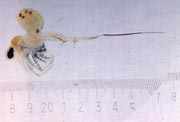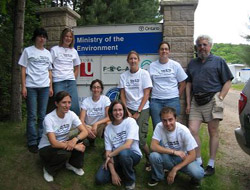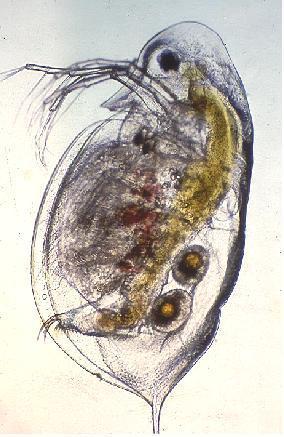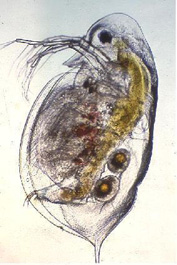|
My group’s long-term research goal is to understand
the impacts of multiple environmental stressors on the million lakes of the
Canadian Shield, one of the world’s
foremost freshwater resources. Our focus is on the key pelagic herbivores
of these lakes - the animal plankton.
My interest in multiple stressors began in graduate
school, with my MSc research on the effects of acid rain on phytoplankton,
and my doctoral program on the regulation of metal bioaccumulation by
animal plankton. With this applied science background, I joined the Ontario
Ministry of the Environment (MOE) for 25 years of work on what can go wrong
with our lakes, and how the damage can be fixed. In 2000 I joined the
Biology Department at York, and I split my
time between York University, and the MOE’s Dorset Environmental
Research Centre (DESC), 2.5 hours north of Toronto
near Algonquin
Park. The DESC lies in
beautiful forested landscape dotted with 1000’s of lakes - our study sites.
In partnership with the government, I have built the FLAMES lab, the Field Laboratory for the
Assessment of Multiple Ecological Stressors, at the DESC, and it is the research
home for most of my graduate students. My current main areas of research
are: (1) determining the individual and joint impacts on aquatic food webs
of non-indigenous species and (2) changes in climate, acidity, calcium, and
nutrients, and (3) quantifying the regulators of recovery of lakes from
past environmental damage. Our lab has been quite productive, authoring
over 100 publications. and receiving
several awards of excellence for our work,
but I gain most satisfaction from the knowledge that our research has both
contributed to improved management of Ontario’s lakes, and led, on occasion
to substantial and sustained recovery of lakes and their biota from
historical damage (paper1,
paper2). The
current most active areas of research in the lab are:
The spread and impacts of Aquatic Invading Species,
eg. the spiny water flea
Next to habitat loss, the introduction of  non-indigenous
species is the most important cause of global biodiversity loss. We are
seeking to understand the current and future threat of non-indigenous
species to the lakes of the Canadian Shield.
Our model species is the spiny water flea, Bythotrephes (right). non-indigenous
species is the most important cause of global biodiversity loss. We are
seeking to understand the current and future threat of non-indigenous
species to the lakes of the Canadian Shield.
Our model species is the spiny water flea, Bythotrephes (right).
It was brought to North America in ship ballast
water, and introduced into the Great Lakes.
We first found it in the lakes of Muskoka in 1989, and it has since spread
to almost 50 lakes in the region. Bythotrephes is a very damaging
invader leading to 30-40% reduction in native biodiversity of animal
plankton. We were the first in North America
to document the spread of Bythotrephes into inland lakes, and to
document its damaging affects on native biota (Yan
et al. 2002, Yan and Pawson 1997, Boudreau
and Yan 2003). There are currently 5 Bythotrephes graduate
projects in the lab. With a large crew of helpers,  we sampled 300
lakes in Muskoka to document the current invasion situation. For her PhD, Joelle Young is developing a deep
understanding of the ecology and life history of the invader in lakes with
different fish assemblages. Erika Weisz’
MSc is focused on habitat invasibility by Bythotrephes, and its
interaction with competing macroinvertebrate predators. In her MSc, Jen
Petruniak is identifying weather conditions that favour mass Bythotrephes
dispersal down lake outflows. Finally, Natalie Kim’s
MSc research is designed to identify the physical and chemical factors in
receiving waters that affect the probability of establishment of Bythotrephes
colonists. we sampled 300
lakes in Muskoka to document the current invasion situation. For her PhD, Joelle Young is developing a deep
understanding of the ecology and life history of the invader in lakes with
different fish assemblages. Erika Weisz’
MSc is focused on habitat invasibility by Bythotrephes, and its
interaction with competing macroinvertebrate predators. In her MSc, Jen
Petruniak is identifying weather conditions that favour mass Bythotrephes
dispersal down lake outflows. Finally, Natalie Kim’s
MSc research is designed to identify the physical and chemical factors in
receiving waters that affect the probability of establishment of Bythotrephes
colonists.
Ca decline
Canadian Shield lakes normally
have soft waters, i.e. waters with low concentrations of calcium (Ca), but Ca
levels are currently in decline, and no one knows what the effects of this
decline might be. Ca in Shield lakes are controlled by free Ca levels in
forest soils, and the levels in forest soils are falling because input
rates from mineral weathering and atmospheric deposition are lower than
loss rates attributable to logging and acid deposition. All living
creatures require Ca, but we do not know what Ca concentrations are
limiting for biota on the Shield, nor how the Ca thresholds might interact
with ongoing nutrient decline and climate warming. As Ca levels are
declining across the Shield, as requirements for Ca differ
greatly among species, and as the effects of low Ca are exacerbated
at high temperatures, we see research on effects of Ca decline as an
urgently need. What we currently know about the impacts of Ca decline on
zooplankton comes mainly from the research of two recent students in our lab
– Dawn Ashforth and Adam Jeziorski. Dawn alerted us to the potential for
interactions of Ca decline with global warming. Adam identified the
remarkable inter-species differences in Ca requirements.  Two new MSc
students will build on this pioneering work. Christine
Gibson will determine the temperature and pH-dependency of Ca
thresholds of several Ca-rich zooplankton species. Allegra
Cairns will test these Ca thresholds in the field, determining if
there is predictable damage once the thresholds are passed. I believe that
the interaction of Ca decline with global warming is a critical emerging environmental
issue for large regions of the world’s soft-water lakes. Two new MSc
students will build on this pioneering work. Christine
Gibson will determine the temperature and pH-dependency of Ca
thresholds of several Ca-rich zooplankton species. Allegra
Cairns will test these Ca thresholds in the field, determining if
there is predictable damage once the thresholds are passed. I believe that
the interaction of Ca decline with global warming is a critical emerging environmental
issue for large regions of the world’s soft-water lakes.
Daphnia
–a Ca-rich species
Impacts of multiple stressors, including climate
change
There is a growing realization among applied
ecologists that it no longer makes sense to study the impacts of
environmental stressors in isolation, given the reality of multiple
stressors in nature. Lakes on the Canadian Shield
are now facing both good changes, eg. recovery from acidification and
oligotrophication, and many potential damaging stressors, including road
salt additions, base cation decline, climate change and the spread of
invading species. Research on the joint effects of these multiple stressors
is in its infancy. Much of my own specific work is in this field, for
example (Yan et al., in press). Michelle Palmer’s
PhD will build on this field of work in our lab. Michelle is quantifying
changes that are occurring in response to multiple stressors in three
regions with long-term and large scale data set, i.e. Dorset, Sudbury and Wisconsin.
Recovery from historical damage
One real test of ecological knowledge is if we can
understand inter-species and species-habitat relationships well enough to
restore ecosystems from historical damage. As I have been working on
recovery of lakes from acidification and metal contamination for more than
two decades, I am convinced that there is no more satisfying field of work
for an applied ecologist than restoration ecology. Given its importance I
am joined in this work by colleagues from several Ontario
and Canadian environmental agencies, and colleagues from other countries,
especially Norway,
in a wide-ranging research program. For example, we have been able to
demonstrate complete
recovery of entire species assemblages from chronic and severe
damage. Carrie
Holt’s MSc research documented regional scale recovery of zooplankton
near Sudbury,
the first time this has been demonstrated. With collaboratoring physicists
we are exploring if tree planting and recovery from acidification are
responsible for the profound cooling of Sudbury lakes, a cooling that is
occurring despite global warming. Martha Celis-Salgado’s
PhD research will determine if current, residual metal contamination is
regulating the recovery of zooplankton in Sudbury. Much of this work is performed
on Sudbury
lakes, and here we work in close collaboration with scientists from Laurentian
University’s Co-operative Freshwater Ecology Unit.
|




